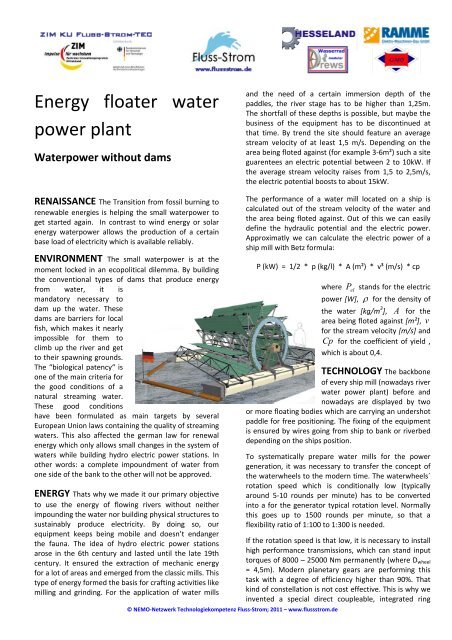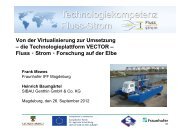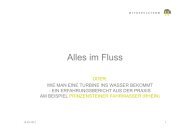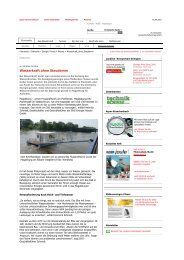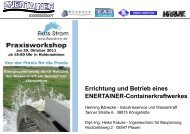Energy floater water power plant - Technologiekompetenz Fluss-Strom
Energy floater water power plant - Technologiekompetenz Fluss-Strom
Energy floater water power plant - Technologiekompetenz Fluss-Strom
Create successful ePaper yourself
Turn your PDF publications into a flip-book with our unique Google optimized e-Paper software.
<strong>Energy</strong> <strong>floater</strong> <strong>water</strong><br />
<strong>power</strong> <strong>plant</strong><br />
Water<strong>power</strong> without dams<br />
RENAISSANCE The Transition from fossil burning to<br />
renewable energies is helping the small <strong>water</strong><strong>power</strong> to<br />
get started again. In contrast to wind energy or solar<br />
energy <strong>water</strong><strong>power</strong> allows the production of a certain<br />
base load of electricity which is available reliably.<br />
ENVIRONMENT The small <strong>water</strong><strong>power</strong> is at the<br />
moment locked in an ecopolitical dilemma. By building<br />
the conventional types of dams that produce energy<br />
from <strong>water</strong>, it is<br />
mandatory necessary to<br />
dam up the <strong>water</strong>. These<br />
dams are barriers for local<br />
fish, which makes it nearly<br />
impossible for them to<br />
climb up the river and get<br />
to their spawning grounds.<br />
The “biological patency“ is<br />
one of the main criteria for<br />
the good conditions of a<br />
natural streaming <strong>water</strong>.<br />
These good conditions<br />
have been formulated as main targets by several<br />
European Union laws containing the quality of streaming<br />
<strong>water</strong>s. This also affected the german law for renewal<br />
energy which only allows small changes in the system of<br />
<strong>water</strong>s while building hydro electric <strong>power</strong> stations. In<br />
other words: a complete impoundment of <strong>water</strong> from<br />
one side of the bank to the other will not be approved.<br />
ENERGY Thats why we made it our primary objective<br />
to use the energy of flowing rivers without neither<br />
impounding the <strong>water</strong> nor building physical structures to<br />
sustainably produce electricity. By doing so, our<br />
equipment keeps being mobile and doesn’t endanger<br />
the fauna. The idea of hydro electric <strong>power</strong> stations<br />
arose in the 6th century and lasted until the late 19th<br />
century. It ensured the extraction of mechanic energy<br />
for a lot of areas and emerged from the classic mills. This<br />
type of energy formed the basis for crafting activities like<br />
milling and grinding. For the application of <strong>water</strong> mills<br />
and the need of a certain immersion depth of the<br />
paddles, the river stage has to be higher than 1,25m.<br />
The shortfall of these depths is possible, but maybe the<br />
business of the equipment has to be discontinued at<br />
that time. By trend the site should feature an average<br />
stream velocity of at least 1,5 m/s. Depending on the<br />
area being floted against (for example 3‐6m²) such a site<br />
guarentees an electric potential between 2 to 10kW. If<br />
the average stream velocity raises from 1,5 to 2,5m/s,<br />
the electric potential boosts to about 15kW.<br />
The performance of a <strong>water</strong> mill located on a ship is<br />
calculated out of the stream velocity of the <strong>water</strong> and<br />
the area being floted against. Out of this we can easily<br />
define the hydraulic potential and the electric <strong>power</strong>.<br />
Approximatly we can calculate the electric <strong>power</strong> of a<br />
ship mill with Betz formula:<br />
P (kW) = 1/2 * p (kg/l) * A (m²) * v³ (m/s) * cp<br />
© NEMO‐Netzwerk <strong>Technologiekompetenz</strong> <strong>Fluss</strong>‐<strong>Strom</strong>; 2011 – www.flussstrom.de<br />
where P el stands for the electric<br />
<strong>power</strong> [W], ρ for the density of<br />
the <strong>water</strong> [kg/m 3 ], A for the<br />
area being floted against [m²], v<br />
for the stream velocity [m/s] and<br />
Cp for the coefficient of yield ,<br />
which is about 0,4.<br />
TECHNOLOGY The backbone<br />
of every ship mill (nowadays river<br />
<strong>water</strong> <strong>power</strong> <strong>plant</strong>) before and<br />
nowadays are displayed by two<br />
or more floating bodies which are carrying an undershot<br />
paddle for free positioning. The fixing of the equipment<br />
is ensured by wires going from ship to bank or riverbed<br />
depending on the ships position.<br />
To systematically prepare <strong>water</strong> mills for the <strong>power</strong><br />
generation, it was necessary to transfer the concept of<br />
the <strong>water</strong>wheels to the modern time. The <strong>water</strong>wheels´<br />
rotation speed which is conditionally low (typically<br />
around 5‐10 rounds per minute) has to be converted<br />
into a for the generator typical rotation level. Normally<br />
this goes up to 1500 rounds per minute, so that a<br />
flexibility ratio of 1:100 to 1:300 is needed.<br />
If the rotation speed is that low, it is necessary to install<br />
high performance transmissions, which can stand input<br />
torques of 8000 – 25000 Nm permanently (where Dwheel<br />
= 4,5m). Modern planetary gears are performing this<br />
task with a degree of efficiency higher than 90%. That<br />
kind of constellation is not cost effective. This is why we<br />
invented a special direct coupleable, integrated ring
segment generator for the project “<strong>Energy</strong> <strong>floater</strong>” to<br />
convert energy without gear!<br />
CONSTRCTION Also the production‐ and material<br />
technology have made a large step forwards. High‐<br />
quality steel, aluminium, FBE/CFL and CNC‐based/<br />
controlled manufacturing processes are replacing the<br />
carpenters work. Very expensive special editions to<br />
adapt to geographical circumstances of a specific<br />
location are not necessary anymore. In the sense of<br />
customized clothing our modular system, based on<br />
standardized elements (pontoons, <strong>Fluss</strong>‐<strong>Strom</strong>‐TEC‐<br />
Teflon‐Polyamide‐plain‐bearing; generator, stator<br />
segments etc.) allows the individual batch production of<br />
modern and cheap ship mills to produce electric current<br />
economically.<br />
BUSINESS This includes the unmanned operation<br />
with remote monitoring and ‐control. State enquiries<br />
and changes of operational sequences like stopping the<br />
wheel can be performed easily from home via mobile<br />
phone, PC, or internet.<br />
In hydrological institutes you can find for virtually all<br />
streaming <strong>water</strong>s in Germany and Europe a certain list,<br />
in which the flow rates are shown. The feeding of<br />
electric current into the open electric grid and its<br />
compensation is guaranteed by law for 20 years. With its<br />
last amendment, the compensation for electricity fed<br />
into the grid coming from small hydro electric <strong>power</strong><br />
stations (under 500kW) has been raised to 12,67<br />
Cent/kWh. Based on these numbers it is possible to<br />
make investment decisions.<br />
PROFITABLENESS Assuming a rate of availability of<br />
85%, which corresponds to an annual operating time of<br />
44 weeks or 7400 hours, you should take a look on the<br />
following example:<br />
Clamshell‐<strong>water</strong>wheel: Example I<br />
Width = 5m; depth of immersion = 1m; area to be floted<br />
against = 5m²; continuous output at a stream velocity of<br />
1.8 m/s (1,17kW/m²):<br />
5m² * 1,17kW/m² = 5,85kW, generator <strong>power</strong> * 7400h/a<br />
= 43.290kWh/year; annual income guaranteed from the<br />
law for renewable energy: 43.290kWh/year * 0.1267<br />
Euro/kWh = ~ 5485,‐€/year<br />
Investment (bases on batch production of all<br />
components): ~6500,‐€/kW (generator <strong>power</strong>), 5,85kW<br />
(generator <strong>power</strong>) * 6500€/kW = 38.000,‐Euro total<br />
investment leading to an amortization time of 6,9<br />
years.<br />
Clamshell‐<strong>water</strong>wheel: Example II<br />
Same overall size, but faster stream velocity: Width =<br />
5m; depth of immersion = 1m; area to be floted against<br />
= 5m²; continuous output at a stream velocity of 2.2 m/s<br />
(2.13 kW/m²):<br />
5m² * 2.13 kW/m² = 10.65kW, generator <strong>power</strong> *<br />
7400h/a = 78.810 kWh/year; annual income guaranteed<br />
from the law for renewable energy: 78.810kWh/year *<br />
0.1267 Euro/kWh = ~9985,‐€/year<br />
Investment (bases on batch production of all<br />
components): same kit as in Example I, but 2 pieces of<br />
stator segments for a bigger energy extraction = 38.000,‐<br />
EURO + 2 * 4.000,‐ EURO = 46.000,‐ EURO total<br />
investment leading to an amortization time of 4,6<br />
years.<br />
500‐1000€ have to be used for Maintenance and<br />
business.<br />
Fleet of <strong>water</strong> mills for about 100 kW at 2.5 m/s<br />
© NEMO‐Netzwerk <strong>Technologiekompetenz</strong> <strong>Fluss</strong>‐<strong>Strom</strong>; 2011 – www.flussstrom.de


